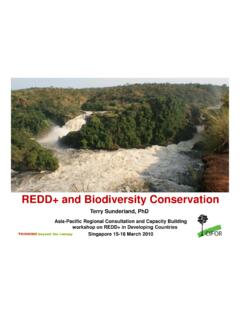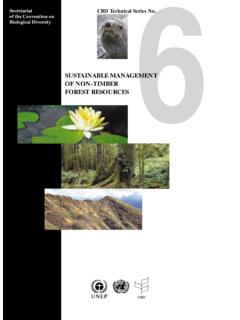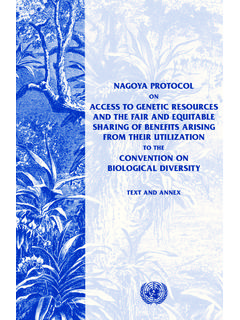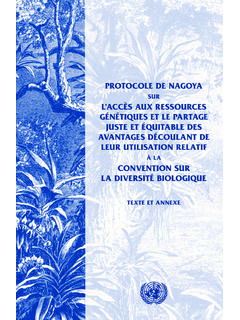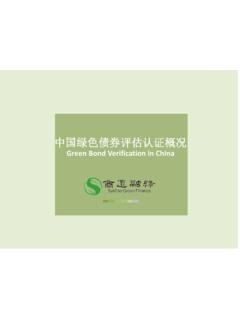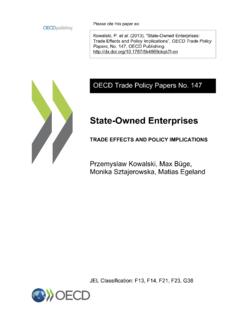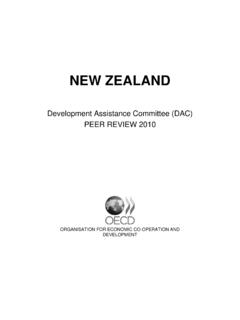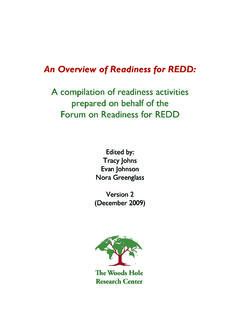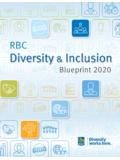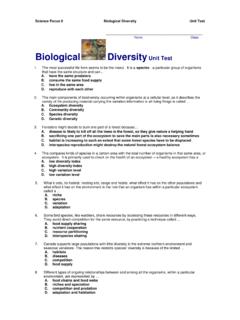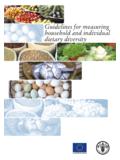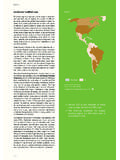Transcription of CONVENTION ON BIOLOGICAL DIVERSITY - CBD
1 CONVENTIONON BIOLOGICAL DIVERSITYUNITED NATIONS1992 CONVENTION ON BIOLOGICAL DIVERSITYP reamble The Contracting Parties,Conscious of the intrinsic value of BIOLOGICAL DIVERSITY and of theecological, genetic, social, economic, scientific, educational, cultural,recreational and aesthetic values of BIOLOGICAL DIVERSITY and also of the importance of BIOLOGICAL DIVERSITY forevolution and for maintaining life sustaining systems of the biosphere,Affirming that the conservation of BIOLOGICAL DIVERSITY is a commonconcern of humankind,Reaffirming that States have sovereign rights over their ownbiological also that States are responsible for conserving theirbiological DIVERSITY and for using their BIOLOGICAL resources in asustainable manner,Concerned that BIOLOGICAL DIVERSITY is being significantly reducedby certain human of the g nerai lack of information and knowledge regardingbiological DIVERSITY and of the urgent need to develop scientific,technical and institutional capacities to provide the basic understandingupon which to plan and implement appropriate measures,Noting that it is vital to anticipate, prevent and attack the causesof significant reduction or loss of BIOLOGICAL DIVERSITY at source,Noting also that where there is a threat of significant reduction orloss of BIOLOGICAL DIVERSITY .
2 Lack of full scientific certainty shouldnot be used as a reason for postponing measures to avoid or minimize sucha further that the fundamental requirement for theconservation of BIOLOGICAL DIVERSITY is the in-situ conservation ofecosystems and natural habitats and the maintenance and recovery ofviable populations of species in their natural surroundings,Noting further that ex-si tu measures, preferably in the country oforigin, also have an important role to play,Recognizing the close and traditional dependence of many indigenousand local communities embodying traditional lifestyles on biologicalresources, and the desirability of sharing equitably benefits arisingfrom the use of traditional knowledge, innovations and practices relevantto the conservation of BIOLOGICAL DIVERSITY and the sustainable use ofits components,Recognizing ai so the vital role that women play in the conservationand sustainable use of BIOLOGICAL DIVERSITY and affirming the neea forthe full participation of women at all levels of policy-making andimplementation for BIOLOGICAL DIVERSITY conservation,Stressing the importance of, and the need to promote, international,regional and global cooperation among States and intergovernmentalorganizations and the non-governmental sector for the conservation ofbiological DIVERSITY and the sustainable use of its components,Acknowledging that the provision of new and additional financialresources and appropriate access to relevant technologies can be expectedto make a substantial difference in the world's ability to address theloss of BIOLOGICAL DIVERSITY ,Acknowledging further that special provision is required to meetthe needs of developing countries.
3 Including the provision of new andadditional financial resources and appropriate access to relevanttechnologies,Noting in this regard the special conditions of the least developedcountries and small island States,Acknowledging that substantial investments are required to conservebiological DIVERSITY and that there is the expectation of a broad rangeof environmental, economic and social benefits from those investments,Recognizing that economic and social development and povertyeradication are the first and overriding priorities of developingcountries,Aware that conservation and sustainable use of BIOLOGICAL diversityis of critical importance for meeting the food, health and other needs ofthe growing world population, for which purpose access to and sharing ofboth genetic resources and technologies are essential,Noting that, ultimately, the conservation and sustainable use ofbiological DIVERSITY will strengthen friendly relations among States andcontribute to peace for humankind,Desiring to enhance and complement existing internationalarrangements for the conservation of BIOLOGICAL DIVERSITY and sustainableuse of its components, andDetermined to conserve and sustainably use BIOLOGICAL DIVERSITY forthe benefit of present and future agreed as follows:Article I.
4 ObjectivesThe objectives of this CONVENTION , to be pursued in accordance withits relevant provisions, are the conservation of BIOLOGICAL sustainable use of its components and the fair and equitable sharingof the benefits arising out of the utilization of genetic resources,including by appropriate access to genetic resources and by appropriatetransfer of relevant technologies, taking into account all rights overthose resources and to technologies, and by appropriate tic I e 2. Use of TermsFor the purposes of this CONVENTION :" BIOLOGICAL DIVERSITY " means the variability among living organisms fromall sources including, inter alia, terrestrial, marine and other aquaticecosystems and the ecological complexes of which they are part: thisincludes DIVERSITY within species, between species and of ecosystems." BIOLOGICAL resources' includes genetic resources, organisms or partsthereof, populations, or any other biotic component of ecosystems withactual or potential use or value for humanity.
5 "Biotechnology" means any technological application that uses biologicalsystems, living organisms, or derivatives thereof, to make or modifyproducts or processes for specific use."Country of origin of genetic resources" means the country whichpossesses those genetic resources in in-situ conditions."Country providing genetic resources' means the country supplying geneticresources collected from in~situ sources, including populations of bothwild and domesticated species, or taken from ex-si tu sources, which mayor may not have originated in that country."Domesticated or cultivated species' means species in which theevolutionary process has been influenced by humans to meet their needs."Ecosystem" means a dynamic complex of plant, animal and micro-organismcommunities and their non-living environment interacting as a functionalunit."Ex-situ conservation" means the conservation of components of biologicaldiversity outside their natural habitats.
6 "Genetic material" means any material of plant, animal, microbial orother origin containing functional units of heredity."Genetic resources" means genetic material of actual or potential value.'Habitat" means the place or type of site where an organism or populationnaturally conditions' means -onditions where genetic resources existwithin ecosystems and natural habitats, and. in the case of domesticatedor cultivated species, in the surroundings where they have developedtheir distinctive properties."In-situ conservation' means the conservation of ecosystems and naturalhabitats and the maintenance and recovery of viable populations ofspecies in their natural surroundings and, in the case of domesticated orcultivated species, in the surroundings where they have developed theirdistinctive properties."Protected area" means a geographically defined area which is designatedor regulated and managed to achieve specific conservation economic integration organization" means an organizationconstituted by sovereign States of a given region, to which its memberStates have transferred competence in respect of matters governed by thisConvention and which has been duly authorized, in accordance with itsinternal procedures, to sign, ratify, accept, approve or accede to it.
7 "Sustainable use" means the use of components of BIOLOGICAL DIVERSITY ina way and at a rate that does not lead to the long-term decline ofbiological DIVERSITY , thereby maintaining its potential to meet the needsand aspirations of present and future generations."Technology" includes 3. PrincipleStates have, in accordance with the Charter of the United Nationsand the principles of international law, the sovereign right to exploittheir own resources pursuant to their own environmental policies, and theresponsibility to ensure that activities within their jurisdiction orcontrol do not cause damage to the environment of other States or ofareas beyond the limits of national 4. Jurisdictional ScopeSubject to the rights of other States, and except as otherwiseexpressly provided in this CONVENTION , the provisions of this Conventionapply, in relation to each Contracting Party:(a) In the case of components of BIOLOGICAL DIVERSITY , in areaswithin the limits of its national jurisdiction; and(b) In the case of processes and activities, regardless of wheretheir effects occur, carried out under its jurisdiction or control,within the area of its national jurisdiction or beyond the limits ofnational 5.
8 CooperationEach Contracting Party shall, as far as possible and as appropriate,cooperate with other Contracting Parties, directly or. where appropriate,through competent international organizations, in respect of areas beyondnational jurisdiction and on other matters of mutual interest, for theconservation and sustainable use of BIOLOGICAL 6. General Measures for Conservation and Sustainable UseEach Contracting Party shall, in accordance with its particularconditions and capabilities:(a) Develop national strategies, plans or programmes for theconservation and sustainable use of BIOLOGICAL DIVERSITY or adapt forthis purpose existing strategies, plans or programmes which shallreflect, inter alia, the measures set out in this CONVENTION relevant tothe Contracting Party concerned; and(b) Integrate, as far as possible and as appropriate, theconservation and sustainable use of BIOLOGICAL DIVERSITY into relevantsectoral or cross-sectoral plans, programmes and 7.
9 Identification and MonitoringEach Contracting Party shall, as far as possible and as appropriate,in particular for the purposes of Articles 8 to 10:(a) Identify components of BIOLOGICAL DIVERSITY important for itsconservation and sustainable use having regard to the indicative list ofcategories set down in Annex I:(b) Monitor, through sampling and other techniques, the componentsof BIOLOGICAL DIVERSITY identified pursuant to subparagraph (a) above,paying particular attention to those requiring urgent conservationmeasures and those which offer the greatest potential for sustainableuse;(c) Identify processes and categories of activities which have orare likely to have significant adverse impacts on the conservation andsustainable use of BIOLOGICAL DIVERSITY , and monitor their effectsthrough sampling and other techniques; and(d) Maintain and organize, by any mechanism data, derived fromidentification and monitoring activities pursuant to subparagraphs (a),(b) and (c) 8.
10 In-situ ConservationEach Contracting Party shall, as far as possible and as appropriate:(a) Establish a system of protected areas or areas where specialmeasures need to be taken to conserve BIOLOGICAL DIVERSITY :(b) Develop, where necessary, guidelines for the selection,establishment and management of protected areas or areas where specialmeasures need to be taken to conserve BIOLOGICAL DIVERSITY :(c) Regulate or manage BIOLOGICAL resources important for theconservation of BIOLOGICAL DIVERSITY whether within or outside protectedareas, with a view to ensuring their conservation and sustainable use;(d) Promote the protection of ecosystems, natural habitats and themaintenance of viable populations of species in natural surroundings:(e) Promote environmentally sound and sustainable development inareas adjacent to protected areas with a view to furthering protection ofthese areas:(f) Rehabilitate and restore degraded ecosystems and promote therecovery of threatened species, inter alia, through the development andimplementation of plans or other management strategies:(g) Establish or maintain means to regulate, manage or control therisks associated with the use and release of living modified organismsresulting from biotechnology which are likely to have adverseenvironmental impacts that could affect the conservation and sustainableuse of BIOLOGICAL DIVERSITY , taking also into account the risks to humanhealth.
